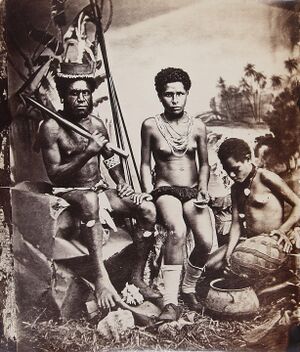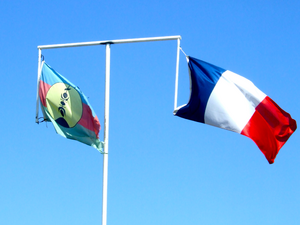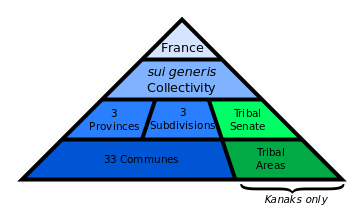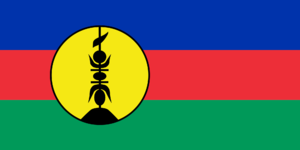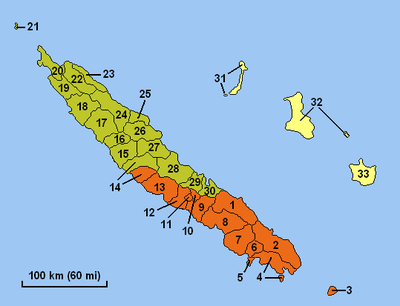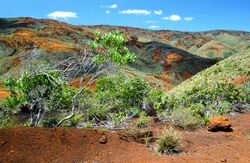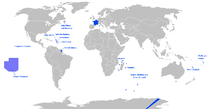كاليدونيا الجديدة
New Caledonia كاليدونيا الجديدة Nouvelle-Calédonie | |
|---|---|
النشيد: La Marseillaise (national) | |
 | |
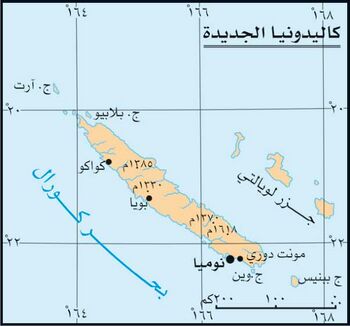 | |
| العاصمة و أكبر مدينة | نوميا |
| اللغات الرسمية | الفرنسية |
| لغات محلية | لغات كاليدونيا الجديدة، لغات جزيرة لولايتي وتايو |
| الحكومة | Dependent territory |
• الرئيس | نيكولا ساركوزي |
| Harold Martin | |
| Albert Dupuy | |
| Sui generis collectivity of France | |
• Annexed by France | 1853 |
| 1946 | |
| 1999 | |
| المساحة | |
• الإجمالية | 18،575 km2 (7،172 sq mi) (رقم 154) |
| التعداد | |
• تقدير Jan. 1, 2009 | 249,000[1] (178th) |
• إحصاء Aug./Sept. 2004 | 230,789[2] |
• الكثافة | 13/km2 (33.7/sq mi) (200th) |
| ن.م.إ. (الإسمي) | تقدير 2007 |
• الإجمالي | US$8.82 billion[3] (not ranked) |
• للفرد | US$36,376[3] (not ranked) |
| م.ت.ب. (2003) | n/a Error: Invalid HDI value · n/a |
| العملة | CFP franc (XPF) |
| التوقيت | UTC+11 |
| مفتاح الهاتف | 687 |
| النطاق العلوي للإنترنت | .nc |

|
|
هذه المقالة هي جزء من سلسلة مقالات عن
التقسيمات الإدارية لفرنسا |
|
(بما فيها مناطق ما وراء البحار) |
|
(بما فيها أقاليم ما وراء البحار) |
|
المجتمعات الحضرية |
|
آخرون في فرنسا وراء البحار
جماعيات وراء البحار |
كاليدونيا الجديدة (فرنسية: Nouvelle-Calédonie [nuvɛl kaledɔni] (![]() استمع))[nb 1] is a sui generis collectivity of overseas France in the southwest Pacific Ocean, south of Vanuatu, about 1،210 km (750 mi) east of Australia,[5] and 17،000 km (11،000 mi) from Metropolitan France. The archipelago, part of the Melanesia subregion, includes the main island of Grande Terre, the Loyalty Islands, the Chesterfield Islands, the Belep archipelago, the Isle of Pines, and a few remote islets.[6] The Chesterfield Islands are in the Coral Sea. French people, especially locals, call Grande Terre le Caillou (pron. [lə kaju], حرفياً 'the stone'), a nickname also used more generally for the entire New Caledonia.[7] Pro-independence Kanak parties use the name (la) Kanaky (pron. [(la) kanaki][nb 2]) to refer to New Caledonia, a term coined in the 1980s from the ethnic name of the indigenous Melanesian Kanak people who make up 41% of New Caledonia's population. New Caledonia is one of the European Union's Overseas Countries and Territories (OCTs),[8] but it is not part of the European Union.[9]
استمع))[nb 1] is a sui generis collectivity of overseas France in the southwest Pacific Ocean, south of Vanuatu, about 1،210 km (750 mi) east of Australia,[5] and 17،000 km (11،000 mi) from Metropolitan France. The archipelago, part of the Melanesia subregion, includes the main island of Grande Terre, the Loyalty Islands, the Chesterfield Islands, the Belep archipelago, the Isle of Pines, and a few remote islets.[6] The Chesterfield Islands are in the Coral Sea. French people, especially locals, call Grande Terre le Caillou (pron. [lə kaju], حرفياً 'the stone'), a nickname also used more generally for the entire New Caledonia.[7] Pro-independence Kanak parties use the name (la) Kanaky (pron. [(la) kanaki][nb 2]) to refer to New Caledonia, a term coined in the 1980s from the ethnic name of the indigenous Melanesian Kanak people who make up 41% of New Caledonia's population. New Caledonia is one of the European Union's Overseas Countries and Territories (OCTs),[8] but it is not part of the European Union.[9]
هي إقليم تابع لفرنسا يقع في أوقيانوسيا. استقر فيها البريطانيين والفرنسيين أثناء النصف الأول من القرن التاسع عشر، وامتلكتها فرنسا في 1853. كانت مستعمرة جزائية لأربعة عقود بعد 1864. عدد سكانها 219246 (يوليو 2006). عاصمتها نوميا.
New Caledonia has a land area of 18،575 km2 (7،172 sq mi) divided into three provinces. The North and South Provinces are on the New Caledonian mainland, while the Loyalty Islands Province is a series of four inhabited islands off the east coast of mainland (from north to south: Ouvéa, Lifou, Tiga, and Maré). New Caledonia's population of 271,407 (October 2019 census)[10] is of diverse origins and varies by geography; in the North and Loyalty Islands Provinces, the indigenous Kanak people predominate, while the wealthy South Province contains significant populations of European (Caldoches and Metropolitan French), Kanak, and Polynesian (mostly Wallisian) origin, as well as smaller groups of Southeast Asian, Pied-Noir, and North African heritage. The capital of New Caledonia is Nouméa.[5]
الجغرافيا
تقع جزر كاليدونيا الجديدة في بحر كورال، وتتشكل أراضيها من مجموعة من الجزر الواقعة في الجزء الجنوبي الغربي من المحيط الهادئ إلى الشرق من أستراليا بمسافة تصل إلى 1780كم، تلامس حدودها الشمالية خط العرض 20 جنوب خط الاستواء، وإلى الجنوب الشرقي منها يمتد بحر فيجي، وتنحصر أراضيها بين خطي الطول 163 ْ و168 ْ شرق جرينتش. تنتمي جزر كاليدونيا الجديدة إلى مجموعة الجزر القارية التي انفصلت عن اليابس المجاور بفضل حركات الهبوط الأرضي أو حركات التصدع التكتونية؛ وتناثرت في أطراف المحيط الذي لم تستطع مياهه غمرها كلياً فأصبحت جزراً قارية النشأة.
تبلغ مساحتها الإجمالية مع الجزر الصغيرة التابعة لها 22,225 كم²، أما من دون هذه الجزر الصغيرة فإن مساحتها لاتزيد على 19100كم2، ولقرب هذه الجزر من دائرة العرض 20جنوب خط الاستواء فإن مناخها يأخذ صفة المناخ المداري الجزري.
التاريخ
تعد كاليدونيا الجديدة والجزر التابعة لها من المواقع المهمة في الجزء الجنوبي الغربي من المحيط الهادئ، وهي من الجزر الكبيرة في مساحتها، إذ تبلغ مساحة الجزيرة الرئيسة فيها (كاليدونيا الجديدة) وحدها 19ألف كم2، إضافة إلى الجزر الأخرى المتمثلة بجزر لويالتي Loyalty وهوون Huon وشِْستَرفيلد Chesterfield وبينس Pins.
ومع بداية الكشوف الجغرافية لجزر القارة الأوقيانوسية مع مطلع القرن السادس عشر أخذت أنظار الدول الأوربية تتجه إلى هذه الجزر المتناثرة في أرجاء المحيط الهادئ، وبدأت أفواج من الأوربيين تهاجر إلى جزر المحيط الهادئ وتستقر فيها، وفي عام 1853 وضعت فرنسا يدها على جزر كاليدونيا الجديدة، ولعله من أهم أسباب احتلال فرنسا لها هو موقعها الذي يشكل حلقة وصل بين أمريكا الشمالية من جهة وأستراليا من جهة ثانية، إضافة إلى ذلك غنى أراضيها بالثروات المعدنية، فكاليدونيا الجديدة هي إحدى أكبر منتجي النيكل في العالم، كما أنها تمتلك إضافة إلى ذلك ثروات معدنية أخرى مثل الكروم والحديد والكوبالت والفضة والذهب والرصاص والنحاس، وعدا عن الثروات المعدنية فإنها تمتلك أيضاً ثروة زراعية تتمثل في زراعة البن ونخيل جوز الهند والموز والأناناس، وبحكم انتمائها للمناخ المداري الذي يناسب مجموعة من المحاصيل الزراعية المهمة للصناعات الأوربية مثل القطن وقصب السكر والمطاط والذرة والتبغ، كل هذه الأمور وغيرها جعلت من هذه الجزر محط أنظار الفرنسيين.

اهتمت فرنسا بجزر كاليدونيا الجديدة في أثناء الحرب العالمية الثانية وبعدها، فأنشأت في العاصمة نوميا مطاراً تهبط فيه الطائرات للتزود بالوقود والمواد الغذائية، كما أنشأت مرفأً يعد واحداً من أهم المرافئ البحرية في جزر المحيط الهادئ. وإضافة إلى ذلك كله تعد جزر كاليدونيا الجديدة محطات استراتيجية للكابلات البحرية الممتدة في المحيط الهادئ، وهي في الوقت ذاته محطات تموين على طرق الملاحة البحرية منها والجوية. هذا فضلاً عن أهميتها مصدراً للطيور النادرة التي لا تشاهد إلا في فرنسا.
تعد كاليدونيا الجديدة والجزر التابعة لها من المواقع المهمة في الجزء الجنوبي الغربي من المحيط الهادئ، وهي من الجزر الكبيرة في مساحتها، إذ تبلغ مساحة الجزيرة الرئيسة فيها (كاليدونيا الجديدة) وحدها 19ألف كم2، إضافة إلى الجزر الأخرى المتمثلة بجزر لويالتي Loyalty وهوون Huon وشِْستَرفيلد Chesterfield وبينس Pins.
ومع بداية الكشوف الجغرافية لجزر القارة الأوقيانوسية مع مطلع القرن السادس عشر أخذت أنظار الدول الأوربية تتجه إلى هذه الجزر المتناثرة في أرجاء المحيط الهادئ، وبدأت أفواج من الأوربيين تهاجر إلى جزر المحيط الهادئ وتستقر فيها، وفي عام 1853 وضعت فرنسا يدها على جزر كاليدونيا الجديدة، ولعله من أهم أسباب احتلال فرنسا لها هو موقعها الذي يشكل حلقة وصل بين أمريكا الشمالية من جهة وأستراليا من جهة ثانية، إضافة إلى ذلك غنى أراضيها بالثروات المعدنية، فكاليدونيا الجديدة هي إحدى أكبر منتجي النيكل في العالم، كما أنها تمتلك إضافة إلى ذلك ثروات معدنية أخرى مثل الكروم والحديد والكوبالت والفضة والذهب والرصاص والنحاس، وعدا عن الثروات المعدنية فإنها تمتلك أيضاً ثروة زراعية تتمثل في زراعة البن ونخيل جوز الهند والموز والأناناس، وبحكم انتمائها للمناخ المداري الذي يناسب مجموعة من المحاصيل الزراعية المهمة للصناعات الأوربية مثل القطن وقصب السكر والمطاط والذرة والتبغ، كل هذه الأمور وغيرها جعلت من هذه الجزر محط أنظار الفرنسيين.
اهتمت فرنسا بجزر كاليدونيا الجديدة في أثناء الحرب العالمية الثانية وبعدها، فأنشأت في العاصمة نوميا مطاراً تهبط فيه الطائرات للتزود بالوقود والمواد الغذائية، كما أنشأت مرفأً يعد واحداً من أهم المرافئ البحرية في جزر المحيط الهادئ. وإضافة إلى ذلك كله تعد جزر كاليدونيا الجديدة محطات استراتيجية للكابلات البحرية الممتدة في المحيط الهادئ، وهي في الوقت ذاته محطات تموين على طرق الملاحة البحرية منها والجوية. هذا فضلاً عن أهميتها مصدراً للطيور النادرة التي لا تشاهد إلا في فرنسا.
وكاليدونيا الجديدة في الوقت الحالي هي أحد أقاليم فرنسا فيما وراء البحار، يتولى السلطة مفوض عام وبرلمان محلي مكون من أربعة وخمسين عضواً منتخباً لمدة ست سنوات، وُتمثَل هذه الجزر بعضوين في الجمعية الوطنية وبعضوٍ في مجلس الشيوخ الفرنسي. [11]
New Caledonia was part of the continent Zealandia, which broke off from the supercontinent Gondwana between 79 million and 83 million years ago.[12] The earliest traces of human presence in New Caledonia date back to the period when the Lapita culture was influential in large parts of the Pacific, ح. 1600–500 BC or 1300–200 BC.[13] The Lapita were highly skilled navigators and agriculturists.[14] The first settlements were concentrated around the coast and date back to the period between c. 1100 BC and AD 200.[13]
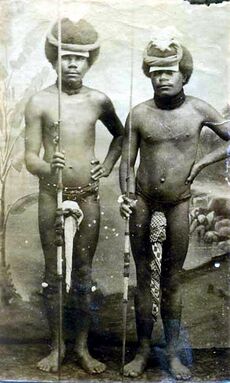
British explorer James Cook was one of the first Europeans to sight New Caledonia, on 4 September 1774, during his second voyage.[15] He named it "New Caledonia", as the northeast of the island reminded him of Scotland.[15] The west coast of Grande Terre was approached by the Comte de Lapérouse in 1788, shortly before his disappearance, and the Loyalty Islands were first visited between 1793 and 1796 when Mare, Lifou, Tiga, and Ouvea were mapped by English whaler William Raven.[16] Raven encountered the island, then named Britania, and today known as Maré (Loyalty Is.), in November 1793.[17] From 1796 until 1840, only a few sporadic contacts with the archipelago were recorded. About 50 American whalers left record of being in the region (Grande Terre, Loyalty Is., Walpole and Hunter) between 1793 and 1887.[17][18] Contacts with visiting ships became more frequent after 1840, because of their interest in sandalwood.[13]
As trade in sandalwood declined, it was replaced by a new business enterprise, "blackbirding", a euphemism for taking Melanesian or Western Pacific Islanders from New Caledonia, the Loyalty Islands, New Hebrides, New Guinea, and the Solomon Islands into slavery, indentured or forced labour in the sugarcane plantations in Fiji and Queensland by various methods of trickery and deception.[19] Blackbirding was practised by both French and Australian traders, but in New Caledonia's case, the trade in the early decades of the twentieth century involved kidnapping children from the Loyalty Islands to the Grand Terre for forced labour in plantation agriculture. New Caledonia's primary experience with blackbirding revolved around a trade from the New Hebrides (now Vanuatu) to the Grand Terre for labour in plantation agriculture, mines, as well as guards over convicts and in some public works. In the early years of the trade, coercion was used to lure Melanesian islanders onto ships. In later years indenture systems were developed; however, when it came to the French slave trade, which took place between its Melanesian colonies of the New Hebrides and New Caledonia, very few regulations were implemented. This represented a departure from contemporary developments in Australia, since increased regulations were developed to mitigate the abuses of blackbirding and 'recruitment' strategies on the coastlines.[بحاجة لمصدر]
The first missionaries from the London Missionary Society and the Marist Brothers arrived in the 1840s.[20] In 1849, the crew of the American ship Cutter was killed and eaten by the Pouma clan.[21] Human cannibalism was widespread throughout New Caledonia.[22]
French colonisation
On 24 September 1853, under orders from Emperor Napoleon III, Admiral Febvrier Despointes took formal possession of New Caledonia. Captain Louis-Marie-François Tardy de Montravel founded Port-de-France (Nouméa) on 25 June 1854.[15] A few dozen free settlers settled on the west coast in the following years.[15] New Caledonia became a penal colony in 1864, and from the 1860s until the end of the transportations in 1897, France sent about 22,000 criminals and political prisoners to New Caledonia. The Bulletin de la Société générale des prisons for 1888 indicates that 10,428 convicts, including 2,329 freed ones, were on the island as of 1 May 1888, by far the largest number of convicts detained in French overseas penitentiaries.[nb 3] The convicts included many Communards, arrested after the failed Paris Commune of 1871, including Henri de Rochefort and Louise Michel.[24] Between 1873 and 1876, 4,200 political prisoners were "relegated" to New Caledonia.[15] Only 40 of them settled in the colony; the rest returned to France after being granted amnesty in 1879 and 1880.[15]
In 1864, nickel was discovered[24] on the banks of the Diahot River; with the establishment of the Société Le Nickel in 1876, mining began in earnest.[25] To work the mines the French imported labourers from neighbouring islands and from the New Hebrides, and later from Japan, the Dutch East Indies, and French Indochina.[24] The French government also attempted to encourage European immigration, without much success.[24]
The indigenous Kanak people were excluded from the French economy and from mining work, and ultimately confined to reservations.[24] This sparked a violent reaction in 1878, when High Chief Ataï of La Foa managed to unite many of the central tribes and launched a guerrilla war that killed 200 Frenchmen and 1,000 Kanaks.[25] A second uprising occurred in 1917, with Protestant missionaries like Maurice Leenhardt functioning as witnesses to the events of this war. Leenhardt would pen a number of ethnographic works on the Kanak of New Caledonia. Noël of Tiamou led the 1917 rebellion, which resulted in a number of orphaned children, one of whom was taken into the care of Protestant missionary Alphonse Rouel. This child, Wenceslas Thi, would become the father of Jean-Marie Tjibaou[26] (1936–1989).
Europeans brought new diseases such as smallpox and measles, which caused the deaths of many natives.[21] The Kanak population declined from around 60,000 in 1878 to 27,100 in 1921, and their numbers did not increase again until the 1930s.[25]
World War II
In June 1940, after the fall of France, the General Council of New Caledonia voted to reject the Vichy government and continue supporting the Allied military effort against Germany. However, the colonial governor Georges-Marc Pélicier promulgated the Vichy government's Constitutional Law, which sparked street demonstrations and an assassination attempt. By this time Caldoches had been in contact with Charles de Gaulle who encouraged them to form a Free French committee and appointed Henri Sautot as governor. The Vichy government despatched a warship, Dumont d'Urville, at Pélicier's request, but soon deemed him incompetent and appointed an acting governor. By this time the Australian government had agreed to intervene and despatched HMAS Adelaide to oversee the installation of Sautot as governor. A stand-off between Dumont d'Urville and Adelaide followed, with Pélicier and other pro-Vichy officials ultimately deported to French Indochina.[27]
In 1941, some 300 men from the territory volunteered for service overseas. They were joined, in April, by 300 men from French Polynesia ('the Tahitians'), plus a handful from the French districts of the New Hebrides: together they formed the Bataillon du Pacifique. The Caledonians formed two of the companies, and the Polynesians the other two. In May 1941, they sailed to Australia and boarded the RMS Queen Elizabeth for the onward voyage to Africa. They joined the other Free French (FF) battalions in Qastina in August, before moving to the Western Desert with the 1st FF Brigade (1re BFL). There they were one of the four battalions who took part in the breakout after the Battle of Bir Hakeim in 1942. Their losses could not easily be replaced from the Pacific and they were therefore amalgamated with the Frenchmen of another battalion wearing the anchor of la Coloniale, the BIM, to form the Bataillon de l'infanterie de marine et du Pacifique. The combined battalion formed part of the Gaulliste 1re Division Motorisée d'Infanterie/Division de Marche d'Infanterie, alongside three divisions from the French North African forces, in the French Expeditionary Corps during the Italian Campaign. They landed in Provence in 1944, when they were posted out and replaced by local French volunteers and résistants.[بحاجة لمصدر]
Meanwhile, in March 1942, with the assistance of Australia,[28] New Caledonia became an important Allied base,[25] and the main South Pacific Fleet base of the United States Navy in the South Pacific moved to Nouméa in 1942–1943.[29] The fleet that turned back the Japanese Navy in the Battle of the Coral Sea in May 1942 was based at Nouméa.[25] American troops stationed on New Caledonia numbered as many as 50,000, matching the entire local population at the time.[15]
French overseas territory
In 1946, New Caledonia became an overseas territory.[15] By 1953, French citizenship had been granted to all New Caledonians, regardless of ethnicity.[30]
During the late 1940s and early 1950s, New Caledonia strengthened its economic links with Australia, particularly as turmoil within France and its empire weakened New Caledonia's traditional economic links to metropolitan France; New Caledonia supplied nickel to Australia in exchange for coal vital for smelting nickel. New Caledonian exports of iron ore and timber to Australia also increased during this time period.[31]
The European and Polynesian populations gradually increased in the years leading to the nickel boom of 1969–1972, and the indigenous Kanak Melanesians became a minority, though they were still the largest ethnic group.[30]
The Events
Between 1976 and 1988, a period referred to as "the Events"[32][33] (فرنسية: Les Événements[34][35]), conflicts between French government actions and the Kanak independence movement saw periods of serious violence and disorder.[15] In 1983, a statute of "enlarged autonomy" for the territory proposed a five-year transition period and a referendum in 1989. In March 1984, the Front Indépendantiste, a Kanak resistance group, seized farms and the Kanak and Socialist National Liberation Front (FLNKS) formed a provisional government. In January 1985, the French Socialist government offered sovereignty to the Kanaks and legal protection for European settlers. The plan faltered as violence escalated. The government declared a state of emergency; however, regional elections went ahead, and the FLNKS won control of three out of four provinces. The centre-right government elected in France in March 1986 began eroding the arrangements established under the Socialists, redistributing lands mostly without consideration of native land claims, resulting in over two-thirds going to Europeans and less than a third to the Kanaks. By the end of 1987, roadblocks, gun battles and the destruction of property culminated in the Ouvéa cave hostage taking, a dramatic hostage crisis just days before the 1988 French presidential election began. Pro-independence militants on Ouvéa killed four gendarmes and took 27 hostage. The military assaulted the cave to rescue the hostages. Nineteen Kanak hostage takers were killed and another three died in custody, while two soldiers were killed during the assault.[36]
Nouméa Accord and independence referendums
The Matignon Agreements, signed on 26 June 1988, ensured a decade of stability. The Nouméa Accord, signed 5 May 1998, set the groundwork for a 20-year transition that gradually transfers competences to the local government.[15]
Following the timeline set by the Nouméa Accord that stated a vote must take place by the end of 2018, the groundwork was laid for a referendum on full independence from France at a meeting chaired by the French Prime Minister Édouard Philippe on 2 November 2017, to be held by November 2018. Voter list eligibility was the subject of a long dispute, but the details were resolved in an electoral list that granted automatic eligibility to voters of Kanak origin but excluded those of other origins who had not been longtime residents of the territory.[37] The referendum was held on 4 November 2018,[38] with independence being rejected.[39]
Another referendum was held in October 2020, with voters once again choosing to remain a part of France.[40] In the 2018 referendum, 56.7% of voters chose to remain in France. In the 2020 referendum, this percentage dropped with 53.4% of voters choosing to remain part of France.[41]
The third referendum was held on 12 December 2021.[42] The referendum was boycotted by pro-independence forces, who argued for a delayed vote due to the impact caused by the COVID-19 pandemic; when the French government declined to do so, they called for a boycott. This led to 96% of voters choosing to stay with France.[43]
In May 2024, riots broke out amid debate over a proposed electoral reform in the territory.[44]
السياسة
New Caledonia is a territory sui generis to which France has gradually transferred certain powers.[45] As such its citizens have French nationality and vote for the president of France. They have the right to vote in elections to the European Parliament. It is governed by a 54-member Territorial Congress, a legislative body composed of members of three provincial assemblies.[46] The French State is represented in the territory by a High Commissioner.[46] At a national level, New Caledonia is represented in the French Parliament by two deputies and two senators.[47] At the 2012 French presidential election, the voter turnout in New Caledonia was 61.19%.[48]
For 25 years, the party system in New Caledonia was dominated by the anti-independence The Rally–UMP.[46] This dominance ended with the emergence of a new party, Avenir Ensemble, also opposed to independence, but considered more open to dialogue with the Kanak movement,[46] which is part of the Kanak and Socialist National Liberation Front, a coalition of several pro-independence groups.[46]
Customary authority
Kanak society has several layers of customary authority, from the 4,000–5,000 family-based clans to the eight customary areas (aires coutumières) that make up the territory.[49] Clans are led by clan chiefs and constitute 341 tribes, each headed by a tribal chief. The tribes are further grouped into 57 customary chiefdoms (chefferies), each headed by a head chief, and forming the administrative subdivisions of the customary areas.[49]
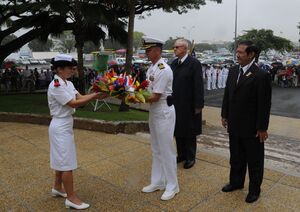
The Customary Senate is the assembly of the various traditional councils of the Kanaks, and has jurisdiction over the law proposals concerning the Kanak identity.[50] The Customary Senate is composed of 16 members appointed by each traditional council, with two representatives per customary area.[50] In its advisory role, the Customary Senate must be consulted on law proposals "concerning the Kanak identity" as defined in the Nouméa Accord.[50] It also has a deliberative role on law proposals that would affect identity, the civil customary statute, and the land system.[50] A new president is appointed each year in August or September, and the presidency rotates between the eight customary areas.[50]
Kanak people have recourse to customary authorities regarding civil matters such as marriage, adoption, inheritance, and some land issues.[49] The French administration typically respects decisions made in the customary system.[49] However, their jurisdiction is sharply limited in penal matters, as some matters relating to the customary justice system, including the use of corporal punishment, are seen as clashing with the human rights obligations of France.[49]
الجيش والشرطة
The Armed Forces of New Caledonia (فرنسية: Forces armées de Nouvelle-Calédonie, or FANC) include about 2,000 soldiers, mainly deployed in Koumac, Nandaï, Tontouta, Plum, and Nouméa.[51] The land forces consist of a regiment of the Troupes de marine, the Régiment d'infanterie de marine du Pacifique. About 80 percent of the 700-member regiment is composed of soldiers on short-term (four month) deployments from metropolitan France. As of 2018, only about 30 personnel in the regiment were locally recruited.[52]
The naval forces incorporate several vessels of the French Navy including: one Floréal، طراز frigate, Vendémiaire, the patrol and support vessel D'Entrecasteaux and Auguste Benebig, the lead ship of the Félix Éboué class of patrol vessels. The French Navy will further reinforce its offshore patrol capabilities in New Caledonia by deploying a second vessel of the Félix Éboué class (Jean Tranape) to the territory by 2025.[53][54] One Engins de Débarquement Amphibie – Standards (EDA-S) landing craft is also to be delivered to naval forces based in New Caledonia by 2025. The landing craft is to better support coastal and riverine operations in the territory.[55]
As of the latter 2010s, French naval aviation and air force elements in New Caledonia included two Navy Falcon 200 Gardian maritime surveillance aircraft (drawn from Flotilla 25F), which are to be replaced by the more modern Falcon 2000 Albatros starting in 2025,[56] plus two Casa CN235 transport aircraft and three Puma helicopters from the Air Force's 52 "Tontouta" Squadron.[57][58] Prior to 2022, the frigate Vendémiaire operated the Alouette III helicopter. However, with the retirement of the type in 2022, it is being replaced by the Eurocopter Dauphin N3.[59][60] In 2022, the French Air Force demonstrated a capacity to reinforce the territory by deploying three Rafale fighters, supported by A400M transport aircraft and A330 MRTT Phénix tankers, from France to New Caledonia for a three-week exercise.[61][62]
In addition, some 855 personnel from the National Gendarmerie are stationed on the archipelago divided into 4 companies, 27 brigades and several specialized and mobile Gendarmerie units. During periods such the 2021 referendum on independence, these forces have been significantly reinforced with personnel deployed from metropolitan France.[63] The air component includes two Écureuil helicopters[64] while the Maritime Gendarmerie deploys the patrol boat Dumbea in the territory.[65][51]
الوضع
New Caledonia has been a member of the Pacific Community since 1983 with Nouméa the home of the organization's regional headquarters. Since 1986, the United Nations Committee on Decolonization has included New Caledonia on the United Nations list of non-self-governing territories.[66] An independence referendum was held the following year, but independence was rejected by a large majority.
Under the Nouméa Accord, signed in 1998 following a period of secessionist unrest in the 1980s and approved in a referendum, New Caledonia was granted special status. Twenty years after inception, the Nouméa Accord required an referendum on independence which was held on 4 November 2018.[67][68] The result was that 56.9% of voters chose to remain with France.[69] The Nouméa Accord required another independence referendum, which was held on 4 October 2020. The result was that 53.26% of voters chose to remain with France.[70] The third and last referendum permitted by the Nouméa Accord was held on 12 December 2021, confirming New Caledonia as part of the French Republic with 96% voting "no" to independence after the vote was boycotted by the bulk of the Kanak population.
The official name of the territory, Nouvelle-Calédonie, could be changed in the near future due to the accord, which states that "a name, a flag, an anthem, a motto, and the design of banknotes will have to be sought by all parties together, to express the Kanak identity and the future shared by all parties."[71] To date, however, there has been no consensus on a new name for the territory, although Kanak Republic is popular among 40% of the population.[72] New Caledonia has increasingly adopted its own symbols, choosing an anthem, a motto, and a new design for its banknotes.[73] In July 2010, the Congress of New Caledonia voted in favour of a wish to fly the Kanak flag of the independence movement FLNKS alongside the French tricolour, as dual flags of the territory. The wish, legally non-binding, proved controversial.[74][75] A majority of New Caledonian communes, but not all, now fly both flags, the rest flying only the French Tricolour.[76] The non-official adoption made New Caledonia one of the few countries or territories in the world with two flags. The decision to wish for the use of two flags has been a constant battleground between the two sides and led the coalition government to collapse in February 2011.[77]
السياسة
كاليدونيا الجديدة في الوقت الحالي هي أحد أقاليم فرنسا فيما وراء البحار، يتولى السلطة مفوض عام وبرلمان محلي مكون من أربعة وخمسين عضواً منتخباً لمدة ست سنوات، وُتمثَل هذه الجزر بعضوين في الجمعية الوطنية وبعضوٍ في مجلس الشيوخ الفرنسي.
الأزمة السياسية 2024
في 13 مايو 2024، اندلعت أعمال شغب في كاليدونيا الجديدة التي يبلغ عدد سكانها 270 ألف شخص، بعد إقرار إصلاح دستوري يهدف إلى توسيع عدد من يُسمح لهم بالمشاركة في الانتخابات، حيث يرى المنادون بالاستقلال أنّ ذلك سيحول السكان الأصليين إلى أقلية. ويقول زعماء السكان الأصليين إن التعديلات، التي ستسمح لمزيد من السكان الفرنسيين بالتصويت في الانتخابات المحلية، ستحد من النفوذ السياسي للسكان الأصليين. وقامت أستراليا ونيوزيلندا بإجلاء رعايا مدنيين جوا.
وأغلق المطار أمام الرحلات الجوية التجارية، وانتشرت قوات من الجيش لحماية المباني العامة.
وقامت قوات الشرطة الفرنسية بمحاولة لاستعادة السيطرة على الطريق الذي يبلغ طوله 60 كيلومترا بين نوميا ولاتونتوتا الدولي، وقامت "بتحييد" 76 حاجزا فضلا عن رفع حطام مثل المركبات المحترقة.
إلا أن نشطاء الكاناك الذي يدعمون الاستقلال أعادوا وضع الحواجز.
وخلال الاحتجاجات قُتل أربعة مدنيين، من بينهم ثلاثة السكان الكاناك الأصليين، في أعمال شغب إلى جانب اثنين من ضباط الشرطة، كما أصيب العشرات واعتقلت السلطات ما يزيد على 200.
وأعلنت فرنسا حالة الطوارئ ونشرت قواتها العسكرية في موانئ الإقليم والمطار الدولي.
أعلنت عمدة مدينة نوميا، عاصمة أرخبيل كاليدونيا الجديدة الواقع في المحيط الهادي، أن المدينة "محاصرة"، وذلك في أعقاب أيام من الاحتجاجات وأعمال الشغب التي خلّفت ستة قتلى.
وقالت عمدة المدينة، سونيا لاغارد، إن العديد من المباني العامة في الأرخبيل قد تم إحراقها وإنه على الرغم من وصول تعزيزات شرطية ضمت المئات من العناصر، إلا أن الوضع ما زال "بعيداً عن العودة إلى الهدوء".
تفيد الأنباء باعتقال أكثر من 200 شخص وبقيام فرنسا بإرسال 1000 شرطي إضافي لينضموا إلى 1700 عنصر موجودين بالفعل في المنطقة.
وتظهر صور التقطت من داخل المنطقة صفوفاً من السيارات المحترقة وحواجز مؤقتة وطوابير من الناس خارج المحلات التجارية.
وأعلنت السلطات المحلية، في يوم 16 مايو حالة الطوارئ التي تشمل حظر تجوال ليلي وفرض حظر كذلك على التجمعات العامة وعلى مبيعات الكحول وحمل السلاح إضافة إلى حظر تطبيق "تيكتوك".
وقد بدأت السلطات الفرنسية، يوم 18 مايو، بتنفيذ ما وصفته بـ "عملية كبيرة" في كاليدونيا الجديدة بمشاركة المئات من عناصر الدرك، لتأمين طريق رئيسي يربط بين نوميا ومطارها الدولي.
في 23 مايو 2024، وصل الرئيس الفرنسي إيمانويل ماكرون إلى كاليدونيا الجديدة، حيث تعهد باستعادة الهدوء بعد أعمال شغب دامية شهدتها الجزيرة الواقعة تحت الحكم الفرنسي في المحيط الهادي بسبب تعديل محل خلاف للنظام الانتخابي. ولدى خروجه من الطائرة في مطار تونتوتا الدولي، قال الرئيس الفرنسي للصحافيين إنه يريد ضمان "عودة السلام والهدوء والأمن في أسرع وقت ممكن".
وأضاف: "هذه هي الأولوية المطلقة". ووقف ماكرون دقيقة صمت حداداً على القتلى الستة، ومن بينهم شرطيان، متعهداً إبقاء قوات الأمن "طالما كان ذلك ضرورياً". وقال ماكرون خلال اجتماع مع القادة السياسيين ورجال الأعمال في العاصمة نوميا: "في الساعات والأيام المقبلة، ستحدد عمليات جديدة واسعة النطاق عند الضرورة، وسيُعاد إرساء النظام الجمهوري برمته لأنه لا يوجد خيار آخر".
وأضاف ماكرون أن ثلاثة آلاف فرد آخرين من رجال الأمن سيبقون في الجزيرة، التي تشهد حالة طوارئ، حتى خلال دورة الألعاب الأولمبية في باريس إن لزم الأمر. وتأتي زيارة ماكرون، التي رُتِّب لها على عجل، إلى كاليدونيا الجديدة اليوم الخميس بعد مقتل ستة أشخاص في أعمال شغب أدت أيضاً إلى نهب متاجر وإحراق سيارات وشركات منذ بدايتها قبل أكثر من أسبوع.
وقال عضو حكومة كاليدونيا كريستوفر جيجيس إنه "بعد وقت قصير جداً من إعلان" الزيارة الرئاسية، تعرضت الجزيرة لهجوم سيبراني "غير مسبوق". وأكد أن الهجوم الذي تضمن إرسال "ملايين رسائل البريد الإلكتروني" بشكل متزامن، أُوقِف "قبل حدوث أضرار جسيمة". وطمأنت وكالة الأمن الإلكتروني الفرنسية أن الهجوم لن تكون له "تداعيات طويلة المدى".[78]
وكانتوكالة "فيغينوم" الحكومية الفرنسية، وهي هيئة تراقب التدخل الرقمي الأجنبي، قد أفادت يوم 17 مايو، بأنها اكتشفت وجود حملة "ضخمة ومنسقة" على الإنترنت للدفع بادعاءات مفادها أن عناصر الشرطة الفرنسية أطلقوا النار على متظاهرين ينادون بالاستقلال في كاليدونيا الجديدة.
وزعمت الحكومة الفرنسية بتورط أذربيجان في الحملة، على الرغم من نفي الحكومة الأربيجانية تلك المزاعم.
ومن جهته قال السيناتور الفرنسي كلود مالوريه إنه "إذا كانت هناك تدخلات غير مرئية بشكل أكبر ويجب الخوف منها، فهي تدخلات الصين".[79]
التقسيمات
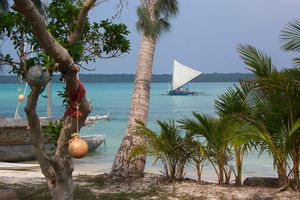
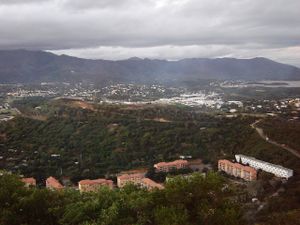
المناخ
البيئة

الاقتصاد
تمثل الزراعة والصيد البحري من الأسماك والمرجان والإسفنج - النشاطين الرئيسين لسكان هذه المجموعة من الجزر، إذ تعد أشجار نخيل جوز الهند عصب الحياة فيها وفي بقية الجزر المتناثرة في المحيط الهادئ، فالمادة السائلة داخل حبات جوز الهند الكبيرة هي المشروب الوحيد للسكان في هذه الجزر التي يندر وجود الماء العذب فيها، ويستخدم زيت جوز الهند في الطهي، أما قشرته الخارجية فتستخدم كأدوات للطبخ، وتستغل ألياف نخيل جوز الهند في صنع الحبال والحقائب وشباك الصيد والقبعات وحتى الملابس. وإضافة إلى جوز الهند هناك أنواع متعددة من الزراعات الأخرى التي يعتمد عليها السكان في حياتهم الاقتصادية، كما أن كثير من المحاصيل الزراعية تستخدم غذاء للسكان مثل: الكومارا واليام والتارو، إضافة إلى زراعة الأرز الذي يزرع بكثرة في هذه الجزر، عدا عن ذلك ثمة محاصيل أخرى مثل البطاطا والكسافا اللذين يعدان من الأغذية الرئيسة في جزر كاليدونيا الجديدة، كذلك تنتشر زراعة الموز والفاكهة المدارية، وخاصة الأناناس والمانغو. أما السكان الأوربيون فقد اقتصر نشاطهم الزراعي في هذه الجزر على زراعة كل من قصب السكر والمطاط والقطن والذرة والتبغ، كما تربى فيها الأبقار والماعز والخنازير، وتسعى كاليدونيا الجديدة إلى اجتذاب السيّاح الأجانب.
تحتوي أراضي كاليدونيا الجديدة على كميات محدودة من الخامات المعدنية التي يستغل بعضها استغلالاً اقتصادياً، ولاسيما الفوسفات والنيكل وخام الكروم، أما بقية الصناعات الأخرى فهي محدودة، حيث يوجد فيها بعض أنواع الصناعات الغذائية والنسيجية والخشبية، ولعل من أهم الصناعات في هذه الجزر صناعة السكر والزيوت النباتية وصناعة تعليب الأسماك. وتعد عاصمتها نوميا سوقاً كبيرة للتبادلات التجارية في المحيط الهادئ، كما أنها ملتقى للسفن الكبيرة على أرصفة مينائها الواسعة.
الديموغرافيا

المجموعات العرقية في كاليدونيا الجديدة هي: 42.5 % ميلانيسيون، 37.1 % أوروبيون، 8.4 % واليسيون، 3.8 % بولينيزيون، 3.6 % إندونيسيون، 1.6 % فيتناميون، وعدد من الجزائريين الذين ينحدرون من المنفيين من الجزائر في القرن 19م بعد مقاومة الشيخ المقراني للاحتلال الفرنسي. اللغة الرسمية في كاليدونيا الجديدة هي اللغة الفرنسية، كما توجد فيها 33 لهجة ميلانيسية بولينيزية. واهم المحاصيل هي البصل والكراث والفجل والكرفس موجود بكثره. وفيها ضفعة كبيرة جدا ذات منظر خلاب.
بلغ عدد سكان هذه الجزر إلى 233ألف نسمة عام 2004، وبذلك تكون الكثافة الحسابية فيها نحو 11نسمة/كم2، أما إذا استثنيت الجزر الصغيرة التي تكاد تخلو من السكان، فإن الكثافة السكانية ترتفع إلى 12نسمة/كم2. وحسب تقديرات صندوق السكان التابع لهيئة الأمم المتحدة فإن عدد سكان كاليدونيا الجديدة سيصل إلى 382 ألف نسمة في عام 2050م.
تختلف أصول السكان في جزر كاليدونيا الجديدة، إذ ترجع أصول غالبية السكان إلى ميلانيزيا المجاورة، ومنذ بداية القرن السادس عشر بدأت العناصر الأوربية تتوافد إلى هذه الجزر، وقد عملت هذه الجماعات على تغيير أوجه النشاط الاقتصادي بهذه الجزر، مما أدى إلى تناقص أعداد السكان الأصليين فيها تدريجياً، وخاصة في القرن السابع عشر. ومنذ أواخر القرن الثامن عشر أخذت عناصر أندونيسية تصل إلى كاليدونيا الجديدة لتدخل إلى هذه الجزر أشكالاً وتراكيب جنسية جديدة، وفي الوقت الحالي تبلغ نسبة السكان الأوربيين 34% من إجمالي السكان، وغالبيتهم من أصول فرنسية، أما نسبة الميلانيزيين فهي 55%، وتبلغ نسبة الأندونيسيين وغيرهم من الأجناس الأخرى 11% من إجمالي السكان.
بلغ معدل النمو السكاني في كاليدونيا الجديدة 2.2% سنوياً في الفترة الممتدة مابين عامي 2000ـ2005، أما معدل الخصوبة الإجمالي فبلغ نحو 2.5% للنساء اللواتي تراوح أعمارهن ما بين 15ـ49سنة في حين كان معدل المواليد للنساء اللواتي تراوح أعمارهن مابين 15ـ19 سنة 13 في الألف في هذه الفئة العمرية، أما معدل الوفيات فإنه يصل إلى 7 في الألف عموماً، في حين يرتفع هذا المعدل بين الأطفال الذين تقل أعمارهم عن خمس سنوات، إذ تحدث 9 حالات وفاة لكل ألفٍ من الذكور و10حالات وفاة عند الإناث، وهكذا فإن العمر المتوقع عند الولادة أو ما يدعى بمتوسطات الأعمار يصل حتى 75سنة، على الرغم من وجود فارق بين الإناث والذكور.
يعيش مانسبته 61.2% من مجموع السكان في مراكز عمرانية مدنية، وتعد مدينة نوميا Nouméa أكبر مدينة في كاليدونيا الجديدة وهي العاصمة الإدارية لهذه الجزر، وقد وصل عدد سكانها إلى مايزيد على 75ألف نسمة عام 2004، وهذه المدينة مرفأ مهم في كاليدونيا وهناك من يرى أنه أهم مرفأ في جزر المحيط الهادئ، إذ يشتهر بأنه من الموانئ النشطة وبعرض أرصفته التي قلما يوجد مثلها في مدن جزر المحيط الهادئ كلها باستثناء أستراليا.إضافة إلى العاصمة نوميا هناك مدينة «مونت دوري» Mont-Dore التي تلي العاصمة من حيث أهميتها الاقتصادية وعدد السكان أيضاً.
تعد اللغة الفرنسية اللغة الرسمية في كاليدونيا الجديدة، أما الديانات السائدة فيها فهما المسيحية والإسلام، فهناك ما نسبته 76% من السكان يدينون بالمسيحية،وهؤلاء يتوزعون إلى 59% من أتباع المذهب الكاثوليكي، و41% من أتباع المذهب البروتستنتي. أما البقية فمعظمهم من أتباع الديانة الإسلامية، إضافة إلى قلة من أتباع المذاهب الطبيعية.
اللغات
الثقافة
الرياضة

اقتصاد
كاليدونيا الجديدة لها حوالي 25 % من النيكل العالمي المعروف. فقط مساحة صغيرة من الأرض مناسبة للزراعة، ويمثل الغذاء حوالي 20 % من الاستيرادات. بالإضافة إلى النيكل، تحصل على دعم مالي كبير من فرنسا يساوي أكثر من ربع الناتج المحلي الإجمالي، والسياحة هي إحدى مفاتيح الاقتصاد هناك. الاستثمار الجديد الكبير في صناعة النيكل اندمج مع تحسن أسعار النيكل العالمية.
تمثل الزراعة والصيد البحري من الأسماك والمرجان والإسفنج - النشاطين الرئيسين لسكان هذه المجموعة من الجزر، إذ تعد أشجار نخيل جوز الهند عصب الحياة فيها وفي بقية الجزر المتناثرة في المحيط الهادئ، فالمادة السائلة داخل حبات جوز الهند الكبيرة هي المشروب الوحيد للسكان في هذه الجزر التي يندر وجود الماء العذب فيها، ويستخدم زيت جوز الهند في الطهي، أما قشرته الخارجية فتستخدم كأدوات للطبخ، وتستغل ألياف نخيل جوز الهند في صنع الحبال والحقائب وشباك الصيد والقبعات وحتى الملابس. وإضافة إلى جوز الهند هناك أنواع متعددة من الزراعات الأخرى التي يعتمد عليها السكان في حياتهم الاقتصادية، كما أن كثير من المحاصيل الزراعية تستخدم غذاء للسكان مثل: الكومارا واليام والتارو، إضافة إلى زراعة الأرز الذي يزرع بكثرة في هذه الجزر، عدا عن ذلك ثمة محاصيل أخرى مثل البطاطا والكسافا اللذين يعدان من الأغذية الرئيسة في جزر كاليدونيا الجديدة، كذلك تنتشر زراعة الموز والفاكهة المدارية، وخاصة الأناناس والمانغو. أما السكان الأوربيون فقد اقتصر نشاطهم الزراعي في هذه الجزر على زراعة كل من قصب السكر والمطاط والقطن والذرة والتبغ، كما تربى فيها الأبقار والماعز والخنازير، وتسعى كاليدونيا الجديدة إلى اجتذاب السيّاح الأجانب.
تحتوي أراضي كاليدونيا الجديدة على كميات محدودة من الخامات المعدنية التي يستغل بعضها استغلالاً اقتصادياً، ولاسيما الفوسفات والنيكل وخام الكروم، أما بقية الصناعات الأخرى فهي محدودة، حيث يوجد فيها بعض أنواع الصناعات الغذائية والنسيجية والخشبية، ولعل من أهم الصناعات في هذه الجزر صناعة السكر والزيوت النباتية وصناعة تعليب الأسماك. وتعد عاصمتها نوميا سوقاً كبيرة للتبادلات التجارية في المحيط الهادئ، كما أنها ملتقى للسفن الكبيرة على أرصفة مينائها الواسعة.
معرض الصور
Amédée lighthouse at Nouméa, the world's tallest metal lighthouse
Xodre Cliffs on Lifou
Coral reef off Lifou
The bandstand in Coconut Square, Nouméa
At Ouvéa, 25km of white sand
Ouvéa atoll
انظر أيضا
- قائمة مراجع كاليدونيا الجديدة
- رؤوس مستعمرات كاليدونيا الجديدة
- الاتصالات في كاليدونيا الجديدة
- اقتصاد كاليدونيا الجديدة
- الموسيقى في كاليدونيا الجديدة
- النقل في كاليدونيا الجديدة
- French overseas departments and territories
- التقسيمات الادارية في فرنسا
- Islands controlled by France in the Indian and Pacific oceans
- Zealandia
- Melanesia
المصادر
- ^ (بالفرنسية) Institut de la statistique et des études économiques de Nouvelle-Calédonie (ISEE). "Bilan Economique et Social 2008 (on page 11)" (PDF). Retrieved 14 September 2009.
- ^ (بالفرنسية) INSEE, Government of France. "Recensement général de la population en Nouvelle-Calédonie – 2004". Retrieved 24 June 2007.
{{cite web}}: Check|first=value (help) - ^ أ ب (بالفرنسية) Institut de la statistique et des études économiques de Nouvelle-Calédonie (ISEE). "Chiffres clés". Retrieved 4 November 2008.
- ^ "LOI no 1999-209 du 19 mars 1999 organique relative a la Novelle Calédonie" (PDF). Journal officiel de la République française. 21 March 1999. p. 4223. Archived from the original (PDF) on 2007-06-14.
- ^ أ ب "Présentation". Nouvelle-caledonie.gouv.fr (in الفرنسية). Archived from the original on 30 October 2012. Retrieved 2013-01-30.
- ^ خطأ استشهاد: وسم
<ref>غير صحيح؛ لا نص تم توفيره للمراجع المسماةpres-om - ^ David Stanley (1989). South Pacific Handbook. David Stanley. p. 549. ISBN 978-0-918373-29-8. Archived from the original on 13 April 2016. Retrieved 18 October 2015.
- ^ "European Union Overseas Territories and Countries". OCTA (in الإنجليزية الأمريكية). Archived from the original on 10 December 2023. Retrieved 2023-12-26.
- ^ "Overseas Countries and Territories - European Commission". international-partnerships.ec.europa.eu (in الإنجليزية). Archived from the original on 27 December 2023. Retrieved 2023-12-26.
- ^ "268 767 habitants en 2014". Nouméa: Institute of Statistics and Economic Studies (ISEE-NC). Archived from the original on 13 November 2014. Retrieved 2014-11-16.
- ^ محمد صافيتا. "كاليدونيا الجديدة". الموسوعة العربية. Retrieved 2011-06-10.
- ^ Pappas, Stephanie (25 March 2021). "Hidden boundaries of lost continent 'Zealandia' revealed in incredible detail". LiveScience. Archived from the original on 20 December 2022. Retrieved 30 December 2022.
- ^ أ ب ت "Histoire / La Nouvelle-Calédonie". Nouvelle-caledonie.gouv.fr (in الفرنسية). 2012-11-20. Archived from the original on 30 October 2012. Retrieved 2013-01-30.
- ^ vLogan, Leanne; Cole, Geert (2001). New Caledonia. Lonely Planet. p. 13. ISBN 978-1-86450-202-2. Archived from the original on 13 April 2016. Retrieved 18 October 2015 – via Google Books.
- ^ أ ب ت ث ج ح خ د ذ ر "Rapport annuel 2010" (PDF). IEOM Nouvelle-Calédonie. Archived (PDF) from the original on 10 March 2021. Retrieved 2013-01-30.
- ^ Quanchi, Max; Robson, John (2005). Historical Dictionary of the Discovery and Exploration of the Pacific Islands. Scarecrow Press. ISBN 9780810865280. Archived from the original on 31 May 2022. Retrieved 30 December 2021.
- ^ أ ب "New Caledonia and International Seaport History. The Maritime Heritage Project". Maritimeheritage.org. Archived from the original on 13 November 2017. Retrieved 2017-11-12.
- ^ Langdon, Robert (1983). Where the Whalers Went: An index of the Pacific Ports and Islands visited by American Whalers (and some other ships) in the 19th Century. Canberra: Pacific Manuscripts Bureau. p. 183. ISBN 086784471X.
- ^ Angleviel, Frédéric. "De Kanaka à Kanak: l'appropriation d'un terme générique au profit de la revendication identitaire" [From Kanaka to Kanak: the appropriation of a generic term for the benefit of identity claim] (PDF) (in الفرنسية). Université de la Nouvelle-Calédonie. Archived (PDF) from the original on 9 November 2017. Retrieved 2013-01-30.
- ^ "Charting the Pacific – Places". Abc.net.au. 1998-10-13. Archived from the original on 8 December 2017. Retrieved 2013-01-30.
- ^ أ ب Logan, Leanne; Cole, Geert (2001). New Caledonia. Lonely Planet. p. 15. ISBN 978-1-86450-202-2. Archived from the original on 12 April 2016. Retrieved 18 October 2015 – via Google Books.
- ^ Knauft, Bruce M. (1999). From Primitive to Postcolonial in Melanesia and Anthropology. University of Michigan Press. p. 103. ISBN 978-0-472-06687-2. Archived from the original on 1 January 2016. Retrieved 18 October 2015 – via Google Books.
- ^ Bulletin de la Société générale des prisons. Paris. 1888. p. 980.
{{cite book}}: CS1 maint: location missing publisher (link) - ^ أ ب ت ث ج Aldrich, Robert; Connell, John (2006). France's Overseas Frontier: Départements et territoires d'outre-mer. Cambridge University Press. p. 46. ISBN 978-0-521-03036-6. Archived from the original on 6 August 2020. Retrieved 18 October 2015 – via Google Books.
- ^ أ ب ت ث ج Stanley, David (1989). South Pacific Handbook. David Stanley. pp. 549–. ISBN 978-0-918373-29-8. Archived from the original on 13 April 2016. Retrieved 18 October 2015 – via Google Books.
- ^ Adrian Muckle
- ^ Fisher, Denise (2010). "Supporting the Free French in New Caledonia: First Steps in Australian Diplomacy" (PDF). Explorations: A Journal of French-Australian Connections. 49 (1): 18–37. Archived (PDF) from the original on 24 March 2024. Retrieved 26 May 2024.
- ^ Hasluck, Paul Meernaa Caedwalla (1952). "Chapter 6 – Clearing a Way to Total War, October 1940 – January 1941". The Government and the People, 1939–1941 (PDF). Vol. I (1965 ed.). Canberra: Australian War Memorial. Archived (PDF) from the original on 30 May 2022. Retrieved 6 August 2009.
- ^ Rottman, Gordon L. (2002). World War 2 Pacific Island Guide. Greenwood Publishing Group. p. 71. ISBN 978-0-313-31395-0. Archived from the original on 19 March 2015. Retrieved 18 October 2015 – via Google Books.
In October, the decision was made to relocate the main South Pacific Fleet base from Auckland to Nouméa (FPO SF 131). Unloading facilities were improved by February 1943 and construction immediately began on the naval operating base.
- ^ أ ب New Caledonia على موسوعة بريتانيكا
- ^ Henningham, Stephen (December 2014). "Australia's Economic Ambitions in French New Caledonia, 1945–1955". The Journal of Pacific History. 49 (4): 421–439. doi:10.1080/00223344.2014.976915. JSTOR 24644648. S2CID 154479730. Archived from the original on 29 April 2022. Retrieved 28 April 2022.
- ^ Mannevy, Charlotte; Derel, Mathurin; Guibert, Nathalie (May 15, 2024). "Second night of riots shakes New Caledonia: 'I didn't think it could come to this'". Le Monde. Archived from the original on 24 May 2024. Retrieved 16 May 2024.
- ^ Vinograd, Cassandra; Breeden, Aurelien (May 15, 2024). "France Declares State of Emergency Amid Protests in New Caledonia". The New York Times. Archived from the original on 24 May 2024. Retrieved 16 May 2024.
- ^ Horowitz, Leah S. (May 2009). "Environmental violence and crises of legitimacy in New Caledonia". Political Geography. 28 (4): 248–258. doi:10.1016/j.polgeo.2009.07.001. ISSN 1873-5096. Archived from the original on 16 May 2024. Retrieved 16 May 2024.
- ^ Fisher, Denise (May 2013). France in the South Pacific: Power and Politics. Canberra: ANU Press. doi:10.22459/FSP.05.2013. ISBN 9781922144942.
- ^ Winslow, Donna (June 1991). "Land and Independence in New Caledonia". Cultural Survival Quarterly Magazine (in الإنجليزية). Archived from the original on 13 November 2017. Retrieved 2021-02-11 – via culturalsurvival.org.
- ^ Roger, Patrick (3 November 2017). "Nouvelle-Calédonie : ce que contient l'" accord politique " sur le référendum d'autodétermination" [New Caledonia: what is contained in the 'political agreement' on the self-determination referendum]. LeMonde.fr (in الفرنسية). Archived from the original on 22 June 2018. Retrieved 17 July 2018.
- ^ "New Caledonia sets date for independence referendum". The Guardian. 20 March 2018. Archived from the original on 13 May 2019. Retrieved 25 March 2018.
- ^ "New Caledonia Votes to Remain Part of France". Time.com (in الإنجليزية). Nouméa, New Caledonia. Associated Press. 5 November 2018. Archived from the original on 9 November 2018. Retrieved 2018-11-08.
- ^ Antoine-Perron, Charlotte (4 October 2020). "New Caledonia voters choose to stay part of France". Los Angeles Times (in الإنجليزية). Nouméa, New Caledonia. Associated Press. Archived from the original on 8 October 2020. Retrieved 11 February 2021.
- ^ "New Caledonia referendum: South Pacific territory rejects independence from France". BBC News (in الإنجليزية البريطانية). 2020-10-04. Archived from the original on 4 October 2020. Retrieved 2021-07-08.
- ^ "French territory of New Caledonia held its third and last independence referendum where 96.49 voted against independence". France24. 12 December 2021. Archived from the original on 13 December 2021. Retrieved 12 December 2021.
- ^ Antoine-Perron, Charlotte (12 December 2021). "New Caledonia votes to stay in France; separatists boycott". Associated Press. Archived from the original on 1 April 2022. Retrieved 13 December 2021.
- ^ "New Caledonia: 'Shots fired' at police in French territory amid riots over voting reforms". France 24. Archived from the original on 15 May 2024. Retrieved May 14, 2024.
- ^ خطأ استشهاد: وسم
<ref>غير صحيح؛ لا نص تم توفيره للمراجع المسماةjc - ^ أ ب ت ث ج خطأ استشهاد: وسم
<ref>غير صحيح؛ لا نص تم توفيره للمراجع المسماةundcol - ^ "Les différentes élections". Nouvelle-caledonie.gouv.fr (in الفرنسية). 2011-05-27. Archived from the original on 2011-11-11. Retrieved 2013-01-30.
- ^ "Resultats de l'election presidentielle – Nouvelle Caledonie". Minister of the Interior (in الفرنسية). Government of France. Archived from the original on 26 June 2012. Retrieved 2012-08-06.
- ^ أ ب ت ث ج Anaya 2011, p. 8.
- ^ أ ب ت ث ج "Sénat coutumier". Nouvelle-caledonie.gouv.fr (in الفرنسية). Archived from the original on 30 October 2012. Retrieved 2013-01-30.
- ^ أ ب "Les Forces armées de Nouvelle-Calédonie". Defense.gouv.fr (in الفرنسية). 2012-12-20. Archived from the original on 9 November 2017. Retrieved 2013-01-30.
- ^ Lagneau, Laurent (19 September 2018). "Le Régiment d'Infanterie de Marine du Pacifique-Nouvelle Calédonie se distingue lors d'un exercice en Australie; Zone Militaire". Archived from the original on 12 February 2023. Retrieved 12 February 2023.
- ^ Tanguy, Jean-Marc (4 August 2022). "New French overseas patrol vessels set for 2023 service entry". Shepherd. Archived from the original on 21 November 2022. Retrieved 30 December 2022.
- ^ Groizeleau, Vincent (21 September 2022). "POM : Le premier patrouilleur reprend ses essais à Brest, le second en achèvement à Boulogne". Mer et Marine (in الفرنسية). Archived from the original on 22 September 2022. Retrieved 3 November 2022.
- ^ "First Two EDA-S Next Gen Amphibious Landing Craft Delivered to French DGA". 25 November 2021. Archived from the original on 26 November 2021. Retrieved 10 December 2021.
- ^ "French Navy to receive new eyes in the sky from Dassault". www.aerotime.aero. 19 November 2020. Archived from the original on 13 November 2022. Retrieved 2022-11-18.
- ^ "Forces armées en Nouvelle-Calédonie; Ministère des Armées". Archived from the original on 5 January 2023. Retrieved 11 February 2023.
- ^ "FANC – Bilan du déploiement du BSAOM D'Entrecasteaux dans le Pacifique Sud; Ministère des Armées". 10 February 2023. Archived from the original on 11 February 2023. Retrieved 11 February 2023.
- ^ "French Navy will receive first three Airbus Dauphin N3 at December 1". Air & Cosmos (in الفرنسية). Archived from the original on 13 November 2022. Retrieved 2022-11-18.
- ^ "Marine Nationale Dossier d'Information, p. 23" (PDF). Cols Bleus (in الفرنسية). January 2023. Archived (PDF) from the original on 4 March 2023. Retrieved 2023-03-04.
- ^ "French Air and Space Force Rafales Train Alongside Royal Australian Air Force Growlers". MilitaryLeak. 2022-08-27. Archived from the original on 14 November 2022. Retrieved 2022-11-18.
- ^ "France successfully conducts long-range strategic deployment to Asian-Pacific region". ac.nato.int. Archived from the original on 3 December 2023. Retrieved 28 December 2023.
- ^ Sartre, Julien (2021-12-07). "Covid, mourning and the spectre of violence: New Caledonia prepares for blighted independence vote". The Guardian. Retrieved 2022-11-18.
- ^ "COMGEND – Commandant de la gendarmerie pour la Nouvelle-Calédonie et les îles Wallis et Futuna / Sécurité / Services de l'État / Accueil – Les services de l'État en Nouvelle-Calédonie". www.nouvelle-caledonie.gouv.fr. Archived from the original on 7 November 2022. Retrieved 2022-11-18.
- ^ "Vedette Côtière de Surveillance Maritime (VCSM) Boats". Homelandsecurity Technology. Archived from the original on 7 December 2021. Retrieved 2022-08-28.
- ^ "Trust and Non-Self-Governing Territories (1945–1999)". United Nations. Archived from the original on 6 October 2017. Retrieved 29 June 2017.
- ^ Willsher, Kim (19 March 2018). "New Caledonia sets date for independence referendum". The Guardian. Archived from the original on 25 October 2019. Retrieved 20 March 2018.
- ^ "Paris meeting to prepare New Caledonia independence vote". Radio New Zealand. 2016-02-02. Archived from the original on 8 March 2016. Retrieved 2016-03-08.
- ^ "New Caledonia votes 'non' to independence from France". The Guardian (in الإنجليزية). Reuters. 2018-11-04. Archived from the original on 6 December 2018. Retrieved 2018-11-04.
- ^ "New Caledonia rejects independence from France for second time". The Guardian (in الإنجليزية). 2020-10-05. Archived from the original on 20 April 2021. Retrieved 2020-10-05.
- ^ Government of New Caledonia. "Les accords de Nouméa" (PDF) (in الفرنسية). Archived from the original (PDF) on 5 April 2008. Retrieved 11 August 2008.
- ^ RFO. "Société : La Nouvelle-Calédonie choisit un hymne et une devise". Archived from the original on 27 June 2008. Retrieved 11 August 2008.
- ^ خطأ استشهاد: وسم
<ref>غير صحيح؛ لا نص تم توفيره للمراجع المسماةmonde1 - ^ "Nouvelle-Calédonie: Voeu sur le drapeau Kanaky de 2010". axl.cefan.ulaval.ca. Archived from the original on 23 October 2021. Retrieved 26 November 2021.
- ^ "Voeux n° 1 du treize juillet 2010" (PDF). Archived (PDF) from the original on 17 April 2021. Retrieved 26 November 2021.
- ^ "Roch Wamytan: "descendre le drapeau kanak est un geste ignoble, il ne faut plus parler de destin commun!"". Nouvelle-Calédonie la 1ère. 9 May 2014. Archived from the original on 26 November 2021. Retrieved 26 November 2021.
- ^ "Sarkozy calls for dialogue over New Caledonia violence". France 24. 2011-08-26. Archived from the original on 7 September 2011. Retrieved 2013-01-30.
- ^ "ماكرون يزور كاليدونيا الجديدة ويتعهد بإعادة الأمن والهدوء". العربي الجديد.
- ^ "الرئيس الفرنسي يزور جزيرة كاليدونيا الجديدة وسط استمرار أعمال شغب". بي بي سي.
قرااءت إضافية
- Di Giorgio Wladimir,member of the Pontifical Academy, in "Francs et Kanaks" (Purpose of the n° 51495 résolution).2009.
- Boyer, S.L. & Giribet, G. (2007): A new model Gondwanan taxon: systematics and biogeography of the harvestman family Pettalidae (Arachnida, Opiliones, Cyphophthalmi), with a taxonomic revision of genera from Australia and New Zealand. Cladistics 23(4): 337–361. DOI:10.1111/j.1096-0031.2007.00149.x
المراجع
- كتاب الحقائق العالمي
- محمود رمزي، جغرافية أوقيانوسية، الكتاب الثاني (مطبعة رياض، دمشق 1990).
- صندوق الأمم المتحدة للسكان، حالة سكان العالم (نيويورك 2004).
وصلات خارجية
- Official website (بالفرنسية)
- New Caledonia entry at The World Factbook
- كاليدونيا الجديدة at the Open Directory Project
 Wikimedia Atlas of New Caledonia
Wikimedia Atlas of New Caledonia- كاليدونيا الجديدة travel guide from Wikitravel
- New Caledonia Photos
- Lonely Planet profile
- (بالفرنسية) Website for l'Association Endemia: A thorough presentation of New Caledonian biodiversity
- (بالفرنسية) past and current developments of France's overseas administrative divisions like New Caledonia
- New Caledonia awaits decolonisation
خطأ استشهاد: وسوم <ref> موجودة لمجموعة اسمها "nb"، ولكن لم يتم العثور على وسم <references group="nb"/>
- CS1 الفرنسية-language sources (fr)
- CS1 الإنجليزية الأمريكية-language sources (en-us)
- CS1 maint: location missing publisher
- CS1 الإنجليزية البريطانية-language sources (en-gb)
- Short description is different from Wikidata
- مقالات بلدان تحتاج صيانة
- Pages using infobox country with unknown parameters
- Pages using infobox country or infobox former country with the flag caption or type parameters
- Pages using infobox country or infobox former country with the symbol caption or type parameters
- Articles containing فرنسية-language text
- Pages using Lang-xx templates
- Articles with hatnote templates targeting a nonexistent page
- Articles with unsourced statements from August 2022
- Pages with empty portal template
- دول اوقيانوسية
- كاليدونيا الجديدة
- ميلانيزيا
- مناطق خاصة في الاتحاد الاوروبي
- أقاليم وتجمعات ومناطق فرنسا وراء البحار
- بلدان وأراضي ناطقة بالفرنسية
- زيلانديا
- دول وأقاليم تأسست في 1853
- جغرافيا فرنسا
- أقاليم فرنسا
- بلدان مقترحة


